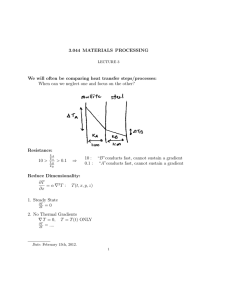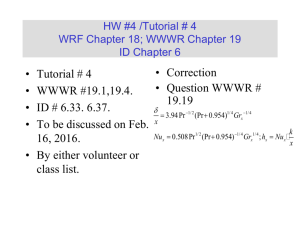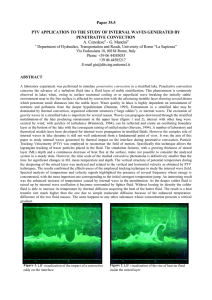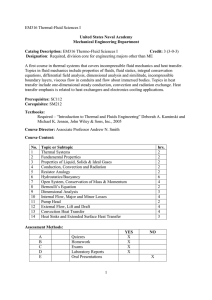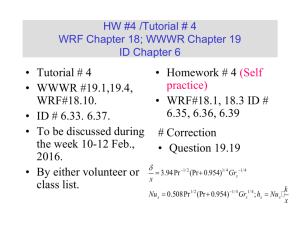PENETRATIVE CONVECTION IN STRATIFIED FLUID: VELOCITY MEASUREMENTS BY IMAGE ANALYSIS
advertisement
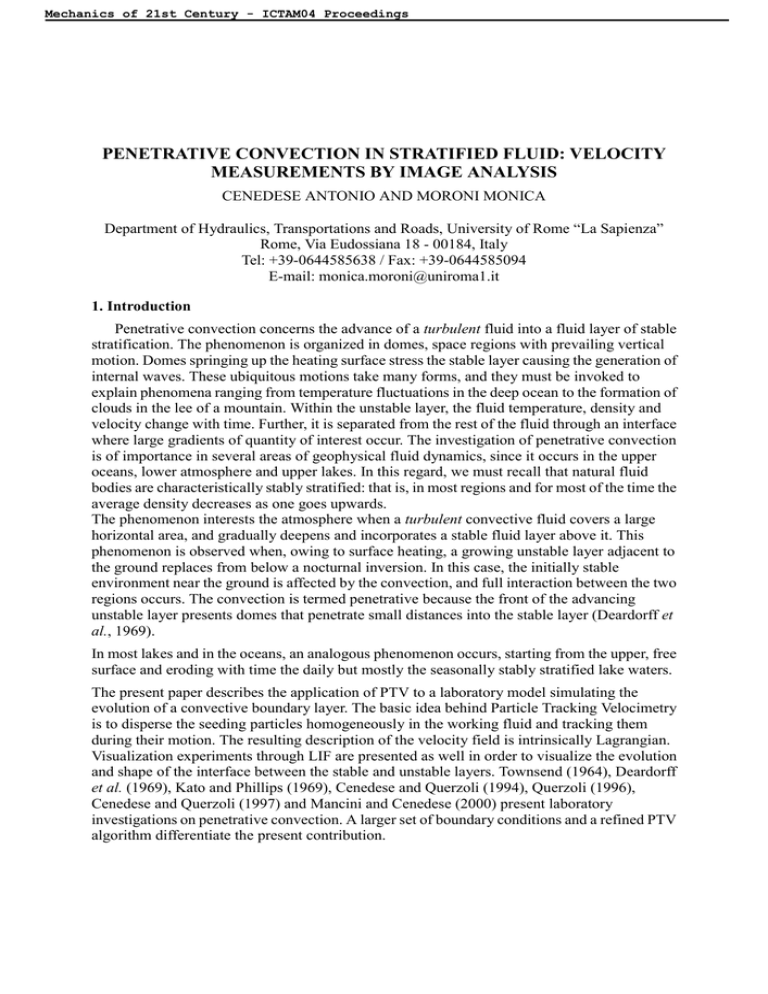
Mechanics of 21st Century - ICTAM04 Proceedings PENETRATIVE CONVECTION IN STRATIFIED FLUID: VELOCITY MEASUREMENTS BY IMAGE ANALYSIS CENEDESE ANTONIO AND MORONI MONICA Department of Hydraulics, Transportations and Roads, University of Rome “La Sapienza” Rome, Via Eudossiana 18 - 00184, Italy Tel: +39-0644585638 / Fax: +39-0644585094 E-mail: monica.moroni@uniroma1.it 1. Introduction Penetrative convection concerns the advance of a turbulent fluid into a fluid layer of stable stratification. The phenomenon is organized in domes, space regions with prevailing vertical motion. Domes springing up the heating surface stress the stable layer causing the generation of internal waves. These ubiquitous motions take many forms, and they must be invoked to explain phenomena ranging from temperature fluctuations in the deep ocean to the formation of clouds in the lee of a mountain. Within the unstable layer, the fluid temperature, density and velocity change with time. Further, it is separated from the rest of the fluid through an interface where large gradients of quantity of interest occur. The investigation of penetrative convection is of importance in several areas of geophysical fluid dynamics, since it occurs in the upper oceans, lower atmosphere and upper lakes. In this regard, we must recall that natural fluid bodies are characteristically stably stratified: that is, in most regions and for most of the time the average density decreases as one goes upwards. The phenomenon interests the atmosphere when a turbulent convective fluid covers a large horizontal area, and gradually deepens and incorporates a stable fluid layer above it. This phenomenon is observed when, owing to surface heating, a growing unstable layer adjacent to the ground replaces from below a nocturnal inversion. In this case, the initially stable environment near the ground is affected by the convection, and full interaction between the two regions occurs. The convection is termed penetrative because the front of the advancing unstable layer presents domes that penetrate small distances into the stable layer (Deardorff et al., 1969). In most lakes and in the oceans, an analogous phenomenon occurs, starting from the upper, free surface and eroding with time the daily but mostly the seasonally stably stratified lake waters. The present paper describes the application of PTV to a laboratory model simulating the evolution of a convective boundary layer. The basic idea behind Particle Tracking Velocimetry is to disperse the seeding particles homogeneously in the working fluid and tracking them during their motion. The resulting description of the velocity field is intrinsically Lagrangian. Visualization experiments through LIF are presented as well in order to visualize the evolution and shape of the interface between the stable and unstable layers. Townsend (1964), Deardorff et al. (1969), Kato and Phillips (1969), Cenedese and Querzoli (1994), Querzoli (1996), Cenedese and Querzoli (1997) and Mancini and Cenedese (2000) present laboratory investigations on penetrative convection. A larger set of boundary conditions and a refined PTV algorithm differentiate the present contribution. Mechanics of 21st Century - ICTAM04 Proceedings 2. Experimental Set-up The laboratory model consists of a convection chamber heated from below. The heating simulates the solar radiation effects and causes penetrative convection. The working fluid is distilled water. Pollen is used as passive tracer. The test section, shown in Figure 1, is a cylindrical tank square cross-section. The insulation is kept while the tank is filled with the density-stratified fluid, and carried out from the side facing the camera, to allow its optical access. The lower boundary can be kept to a given nearly constant temperature by means of a circulating water bath, separated from the fluid through a metal sheet. A stable stratification, e.g. a positive vertical temperature gradient, is obtained by means of two connected tanks. The fluid is initially equally distributed into two identical tanks The thermal convection is started at time t= 0 upon replacing the cool water circulating behind the lower boundary with water at temperature almost equal to the larger achieved within the test section. Within 2 minutes, the temperature at the bottom, increases rapidly to at least 82% of its final value and thereafter gradually approached this value. “Warm” tank “Cold” tank Lamp Lamp Test section Cryostat T=f(t) CCD camera Videorecorder Figure 1 - Experimental set-up 3. Preliminary Results During each experiment, a thermocouple is cycled repeatedly to obtain successive mean temperature profiles. Different sets of initial conditions are investigated. The mean initial temperature gradient, is determined by taking the best fitting straight line of the initial mean profile Figure 2 displays the evolution of the temperature along the vertical direction and as a function of time for one of the performed experiments. Mechanics of 21st Century - ICTAM04 Proceedings 18.0 16.0 14.0 Height (cm) 12.0 2 min 6 min 10.0 10 min 14 min 8.0 18 min 22 min 6.0 26 min 30 min 34 min 4.0 38 min 2.0 0.0 15 16 17 18 19 20 21 22 23 24 Temperature (°C) Figure 2 - Vertical profiles of temperature for experiments 3 Figure 3 shows typical images of the mixing layer and of the interface, acquired during an experiment when fluorescina was placed within the convective layer. The mixing layer evolution can be described in terms of the Rayleigh number: Ra = βg∆T (z * ) 3 λν (2) where: β is the thermal expansion coefficient, λ the thermal diffusivity, ν the fluid cinematic viscosity, g the gravity acceleration, ∆T the difference between the temperature at the boundary where the heat is supplied and the temperature of the mixing layer and z* is the mixing layer height. During the convection phenomenon evolution, Ra increases, mostly because of z* increasing. At first, for low values of Ra, convection is organized in coherent structures, remaining over time. Subsequently, for larger values of Ra, the flow becomes turbulent and the coherent structures spring up and break up continuously in different positions. The horizontal surface is smaller for the upward portions than for the downward ones, having the latter a higher velocity. Their characteristic dimensions are of the same order of magnitude as the mixing layer height, while their lifetime is less or equal to the time a fluid particle needs to complete a whole revolution. At times, the following structures occur: growing domes or turrets with an extremely sharp interface at their top, flat regions of rather large extent occurring after a dome or other structure has spread out or receded, cusp-shaped regions of entrainment pointing into the convective fluid. The images above are analyzed to determine the growth of the mixing layer with time. Each image is characterized by a stable layer (color black) and a mixing layer (lighted-colored). After determining the luminosity vertical profile (averaging the gray level of pixels belonging to each row of the image), the luminosity vertical gradient is computed. The gradient is different than zero at a height corresponding to the interface position. Mechanics of 21st Century - ICTAM04 Proceedings Figure 3 - Visualization of the mixing layer evolution Mechanics of 21st Century - ICTAM04 Proceedings Figure 4 – Centroids reconstructed during the mixing phenomenon (both the effects of penetrative convection and internal waves are depicted) PTV is employed to individuate barycenters and to reconstruct tracer particle trajectories inside the test section. The particle detection algorithm is based on image thresholding (based on the image histogram) and labeling of lighted pixels. The barycenter location is determined with a sub-pixel accuracy. The set of particle image locations is used as input data for the tracking algorithm. The first two points belonging to a trajectory are chosen within a circle of fixed radius. This condition is equivalent to assuming a maximum velocity in the investigated flow. To add spots to the two-point trajectory the nearest neighbor principle is employed. When ambiguities arise, the criterion of “minimum acceleration” along the trajectory passing through the points in question is employed. Figure 4 displays centroids reconstructed inside both the stable and the unstable layers as they evolve with time. Each picture presents the centroids reconstructed analyzing 50 frames. Different pictures refer to different instant of times, being time zero the beginning of the mixing process. Looking at Figure 4 we can conclude that the convective motions grow starting from the lower warm boundary and give rise to upward domes. They coalesce one with the others, forming larger structures with higher velocity. Tracking fluid particle motion, its features can be observed. After a particle leaves the boundary, it travels an upward portion till the inversion layer is reached. At this point, the velocity vertical component goes to zero and changes sign. The particle will now travel the mixing layer downward. Fluid particles belonging to the mixing layer remain trapped within it. After the turbulent region has reached a consistent height, the tracer particles belonging to the interface between the stable and unstable layers start moving along oscillating trajectories (internal waves). As time passes, internal waves are present overall the stable layer. The same particles describing oscillating trajectories Mechanics of 21st Century - ICTAM04 Proceedings are later entrained inside the turbulent fluid. The Brunt Vaisala frequency of internal wave in the stable layer (Townsend, 1996) and Transilient Matrix, which describes the mass exchange in a given amount of time, will be also determined from the analysis of the velocity field in the lagrangiano framework (Mancini & Cenedese, 2000). References Califano, F., Mangeney A., 1994, “Mixed layer in a stably stratified fluid,” Nonlinear Processes in Geophysics, Vol. 1, 199. Cenedese, A., Querzoli G., 1994, “A laboratory model of turbulent convection in the atmospheric boundary layer, ” Atmospheric Environment, Vol. 28, No.11, 1901. Cenedese, A., Querzoli G., 1997, “Lagrangian statistics and transilient matrix measurements by PTV in a convective boundary layer,” Meas. Sci. Technol., Vol. 8, 1553. Cenedese, A., Moroni M. and Querzoli G., “Application of 3D-PTV to the Study of Penetrative Convection”, 10th International Symposium on Flow Visualization, Kyoto (Japan), August, 26-29, 2002. Deardorff, J.W., Willis G.E., Lilly D.K., 1968, “Laboratory investigation of non-steady penetrative convection,” J. Fluid Mech., Vol. 35, No.1, 7. Kato, H., Phillips O.M., 1969, “On the penetration of a turbulent layer into stratified fluid,” J. Fluid Mech., Vol. 37, No.4, 643. Mancini, G., Cenedese A., “Entrainment measurements at a density interface”, 5th International Symposium on Stratified Flows, Vancouver, Canada, July 2000. Querzoli, G., 1996, “A Lagrangian study of particle dispersion in the unstable boundary layer,” Atmospheric Environment, Vol. 30, No.16, 2821. Townsend, A.A., 1966, “Internal waves produced by a convective layer,” J. Fluid Mech., Vol. 24, No.2, 307. << session << start
